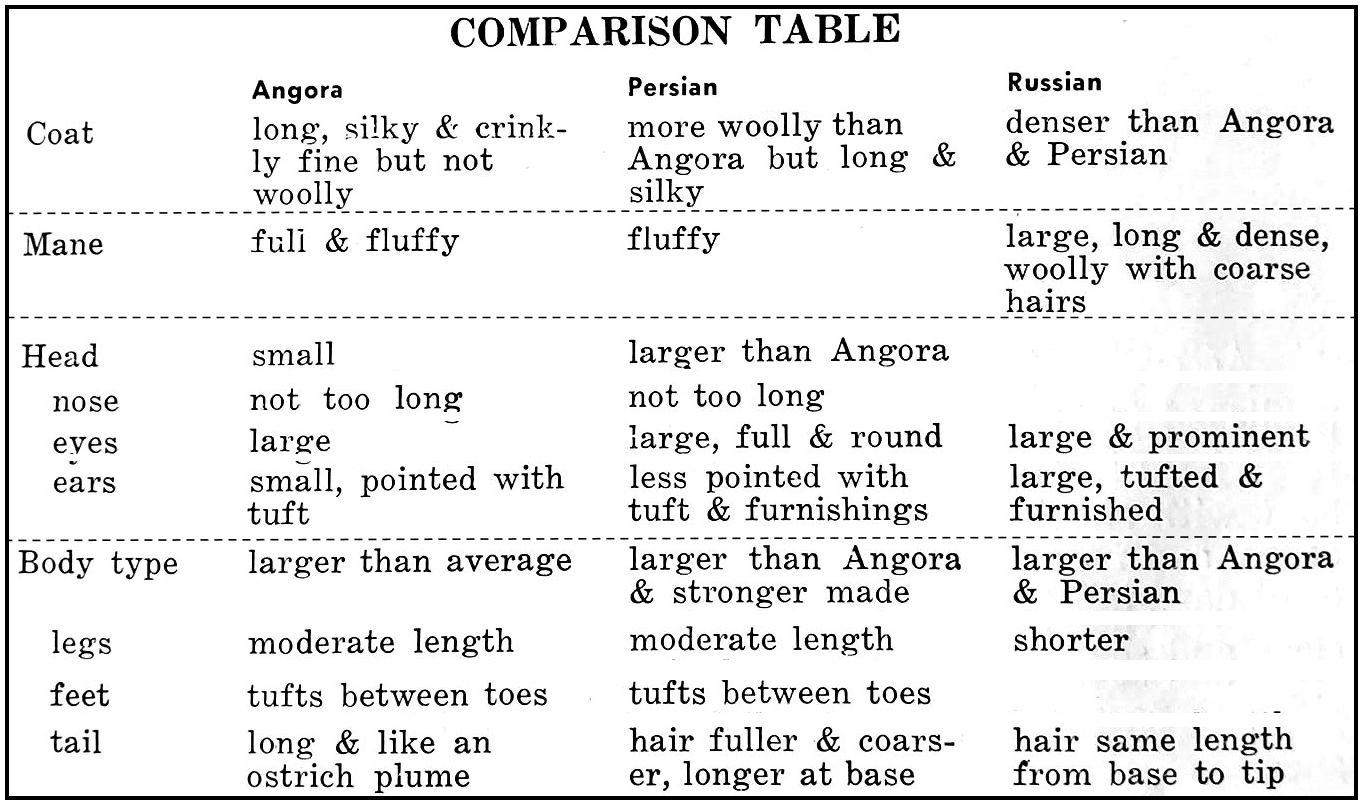|
|
|
|
|
|
||
LONGHAIRED CATS - ANGORA, PERSIAN AND RUSSIAN LONGHAIRS
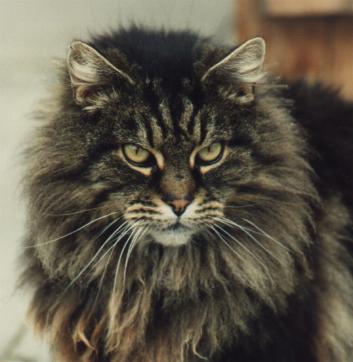
The first longhairs recognised by the western cat fancies were Angoras and Persians whose histories are intertwined. The Persian group is defined as all varieties developed from cats imported from Turkey, Persia (now Iran), Afghanistan and Russia at the turn of the 18th and 19th centuries.

Longhaired cats were first seen in Europe in the 1500s, first in Italy (1521) and then in France. They were named after the Turkish city of Angora (Ankhara). The first documented ancestors of the Persian were imported from Persia into Italy in 1620 by Pietro della Valle, and from Turkey into France by Nicholas-Claude Fabri de Peiresc at around the same time. From France they soon reached Britain. The longhaired cats from Persia were interbred with Turkish Angoras. A tabby Angora cat is depicted in Buffon s "Natural History" (1756). Its head length and conformation are generally similar to the Turkish Angora except that its ears are set lower on the head.
The first longhairs in Britain were variously described as Angoras or as French cats (the latter generally being white). They were also known as Chinese (some longhairs were imported from China where they were known as four-ear cats due to the furnishings of the ear), Russian (the Russian Longhair or Russian Angora was known) and Indian. It was the existence of longhairs in China which led some to speculate that the longhair trait entered the domestic cat population through hybridisation with the Pallas cat. It is suggested that longhairs reached China from Iran (Persia), as a gift of the king of Persia.
The eighteenth-century French naturalist the Comte de Buffon quoted the 16th/17th Century Italian traveller Pietro della Valle: In Europe there is a species of cats which properly belong to the province of Chorazan the USSR and Afghanistan. Their beauty consists in the colour of their hair, which is grey, and uniformly the same over the whole body, except that it is darker on the back and head, and clearer on the breast and belly, where it approaches to whiteness. Besides, the hair is fine, shining, soft as silk, and so long, that, though not frizzled, it forms ringlets in some parts, and particularly under the throat. The most beautiful part of the body is the tail, which is very long, and covered with hair five or six inches in length. They extend and turn it upon their back, like the squirrel, the point resembling a plume of feathers. They are very tame; and the Portuguese have brought them from Persia into India. From this description it appears, that the Persian cats resemble, in colour, those we call Chartreux cats, and that, except in colour, have a perfect resemblance to the cat of Angora.
Buffon had not seen these "Persian" cats himself, but he was familiar with the Angora in France and he apparently believed there was no difference between an Angora and a Persian except in colour (the cat was possibly a black smoke or blue smoke Angora). He named them "Catus Angorensis".
An apparently now extinct longhaired cat from China was known as the Sumxu, a fold-eared cat which was reported from the area around Peking, China. It was a longhaired cat with white fur and pendulous ears. It was described (mostly with regard to its folded ears) several times in the 1700s, with the final report being in 1938; though evidently extinct it indicates the presence of longhairs in China.
In the late 18th century, longhair cats with coarser, denser coats, and a stockier build were imported into Britain from Persia, Afghanistan and Russia. Cats imported from Turkey were mostly whites with a short, soft, silky top coat and little undercoat (and no woolliness in the undercoat). Those from Russia, Afghanistan and Persia were mostly black or blue and less foreign in type. The Angora has a ruff, breeches and a plumy tail, but unlike the later Persian, its coat followed the lines of its body due to the absence of woolly "padding" beneath. The Russian Angoras had green rather than blue, eyes.
A letter from M Lottin de la Val, President of the Imperial Acclimatation Society, to the President of the French Zoological Society in 1856 stated, "When you recently did me the honour of calling on me, you imparted the recently held view that the so called 'Angora' cat does not exist or could not exist except in the vicinity of ancient Ancyra. I hasten to dispel this illusion. I myself came upon specimens of that lovely feline species in the great Armenian plateau, at Erzerum, where the climate is greatly different from that of Angora. The species is very numerous at Mourch in Kurdistan, where it is the dominant variety. I also found it at Billis and in the pashalik of Bayazit.. The finest specimens, however, which I saw belonged to the Archbishop of Van, a town in the east of Kurdistan, on the frontier of Azerbaidjan. He had three of them, one pearl grey, one orange-hued with black and white flecks, and a third, which was completely white. Their fur was magnificent, though there was thought to be nothing to be surprised at in them, as such cats are common in Kurdistan. I also saw some at the residence of Khan Mahmoud, Prince of Hekiars, at Alpeit. I can not recall having seen any in Persia, though, had I thought that scientists might have been interested, I would have taken care to seek them out, busy as I was. But what will surprise you most of all is that despite the high temperatures prevailing, one should find Angora cats at Baghdad, though certainly these are not so fine as those to be found on the northern slopes of the medique and Taurus mountains, though whether the difference is due to the hot atmosphere or the hostility of the people of Baghdad, I cannot say. You will no doubt settle that point better than I could, all I can say is that the people of Baghdad are in constant warfare with their cats, maintaining, not without good reason, in my opinion, that they bring the plague, because of their fur coats and their habits."
While these longhairs might not have been appreciated in their native land, their charms were not lost on British cat fanciers. In "Our Cats" in 1889, Harrison Weir wrote of the various longhaired cats: "There are several varieties - the Russian, the Angora, the Persian, and Indian. Forty or fifty years ago they used to be called French cats, as they were mostly imported from Paris - more particularly the white, which were then very much in fashion."
|
|
|
|
|
|
||
Angoras
It was not until the mid-l9th century that cat enthusiasts distinguished between Turkish Angoras and other long-coated cats coming from Persia and Russia. According to the Illustrated Natural History by the Rev JG Wood (1853, 1874): There are many varieties of the Domestic Cat, of which the most conspicuous are the MANX CAT and the ANGOLA. [...] the Angola Cat being gorgeous in its superb clothing of long silky hair and bushy tail [...] A fine Angola Cat is as handsome an animal as can be imagined, and seems quite conscious of its own magnificence. It is a very dignified animal, and moves about with a grave solemnity that bears a great resemblance to the stately march of a full-plumed peacock conscious of admiring spectators. It is one of the largest of domestic Cats, and in its own superb manner will consume a considerable amount of food. Wood, a naturalist rather than a cat-fancier, evidently meant the Angora.
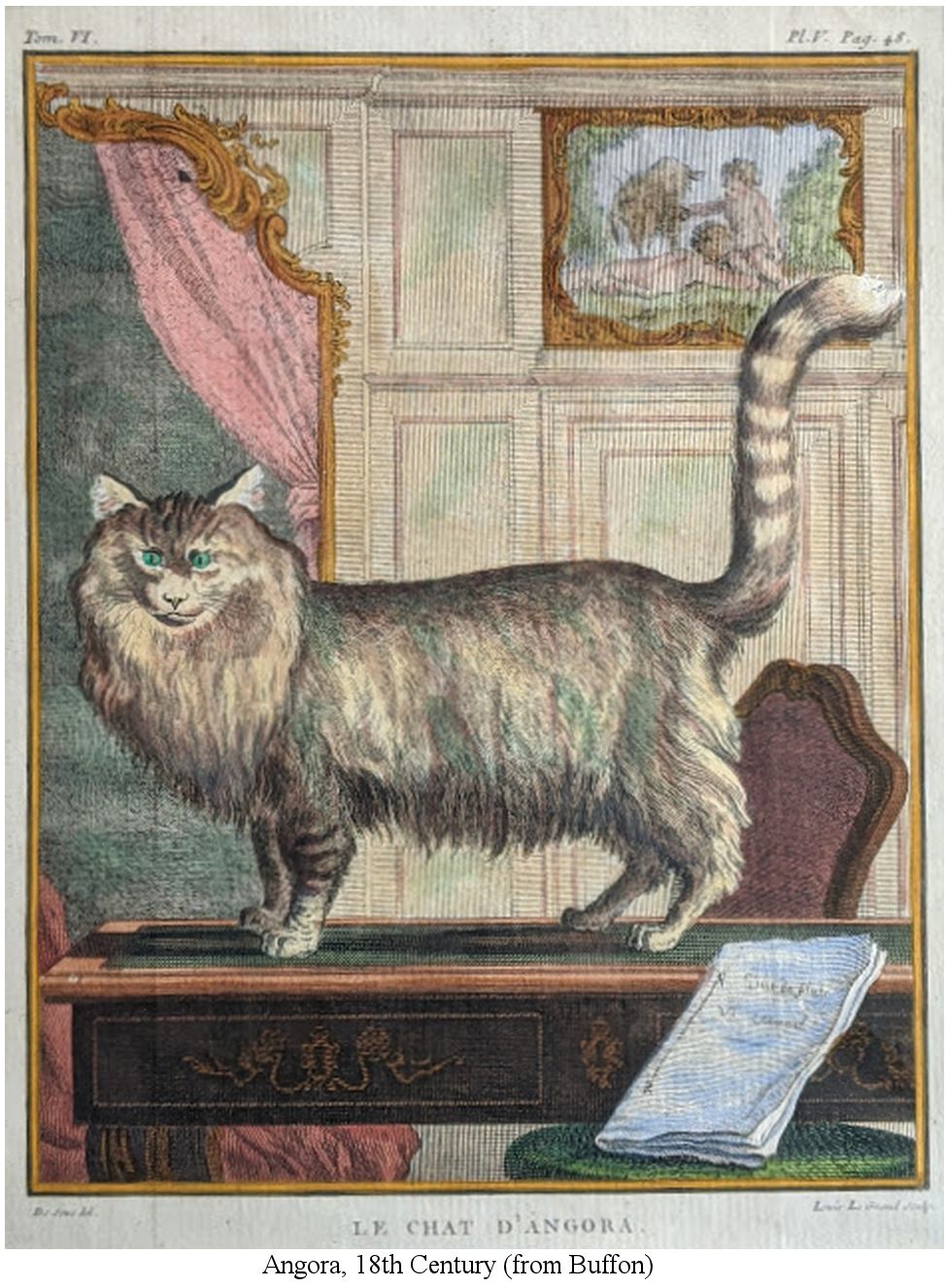
In 1868, an English writer described the Angora as "a beautiful variety with silvery hair of fine texture generally longest on the neck but also on the tail". In the early days of the cat fancy, longhaired breeds competed against each other; the Persian was preferred over the Turkish Angora and the Russian Longhair (Russian Angora), so much so that any resemblance to the Angora was later frowned upon by cat fanciers.
In 1870, the Honourable Lady Cust produced a book called "The Cat" (in which she perceptively wrote "In the present day, a love for cats appears chiefly permitted to 'elderly spinsters,' and is often even ridiculed") in which she described the longhair thus: "Of the wild cat, there is supposed to be only one species, which extends with trifling variety of colour over all parts of the world, the difference from the tame variety being more in the internal than in the external structures, its intestines being the shortest and smalles of all the quadrupeds. [ ] Hiertro dello Valli evidently means the Angora kind when he says 'There is in Persia a cat (particularly in the province of Choragan) of the figure and form of our ordinary ones, but infinitely more beautiful in the lustre and colour of its skin. It is of a grey blue, without mixture, and as soft and shining as silk. The tail is of great length and covered with hair six inches long, which the animal throws on its back like a squirrel.'"
Jean Bungartz described the Angora (Felis maniculata domesticus angorensis) in his 1896 book "Die Hauskatze, ihre Rassen und Variet ten" (Housecats, Their Races and Varieties) in " Illustriertes Katzenbuch" (An Illustrated Book of Cats) as the most beautiful and best known of the foreign cats and originating from high Asia. He summed up the debate over whether the longhair meant it was related to Pallas's Manul or was a housecat adapted to a cold, mountainous climate. He added that there were bluish-grey Angoras in the south Siberians. Bungartz wrote that it could not be proven whether it really came from Angora or just got that reputation because of Angora goats and rabbits from that region. He noted that white and silver (chinchilla?) were most popular, followed by blue, black, "grey-touched" (shaded silver?) and isabelline (cream) while other colour occurred through addition of other blood. He noted that crosses between Angoras and usual housecats lacked the full, rich, silky hair. It was a favourite, and very indulged, salon-cat in Bungartz's time and he described it as calm, aristocratic, attached to humans and a coddled lap-child! He also noted the need to groom its hair to prevent matting ("a horrible, inextricable felt ball") and the need to wipe the eyes clean.
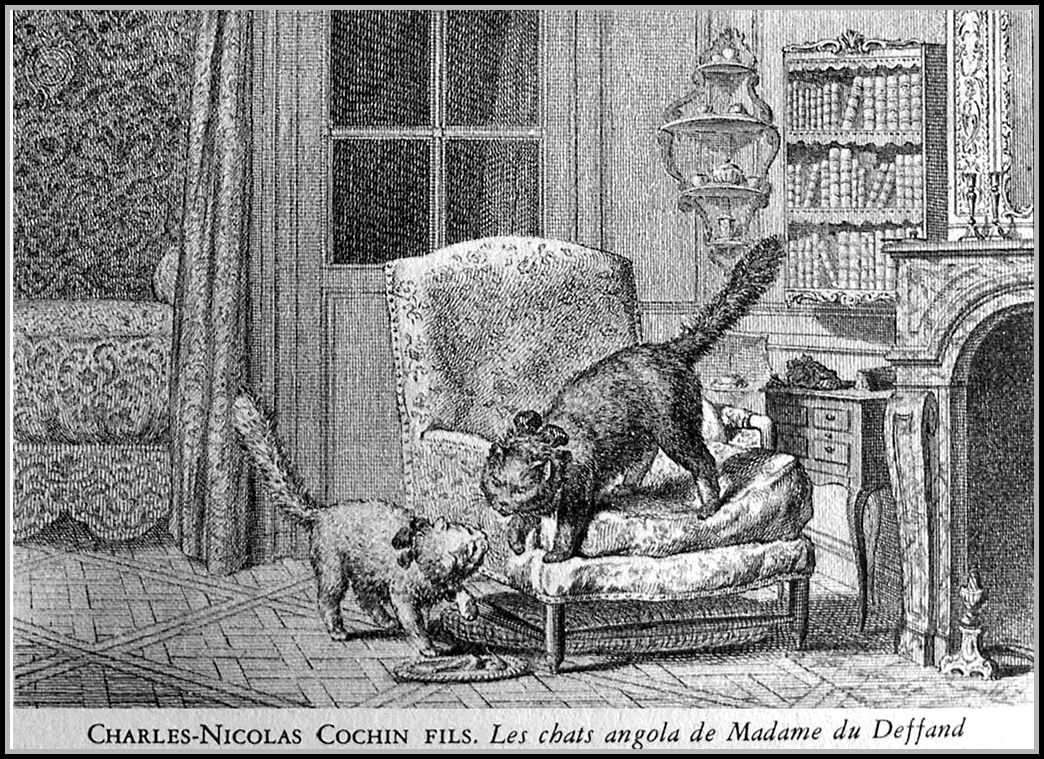
In a footnote to his lengthy notes on the Angora, Bungartz added a short statement about the Persian: "The Khorassan or Persian cat seems to be a modification of the Angora cat, their hair is somewhat more woollier and curlier, but nevertheless still especially long. The colour is dark bluish gray. In terms of beauty, she is quite close to the Angora cat, but is far rarer. "
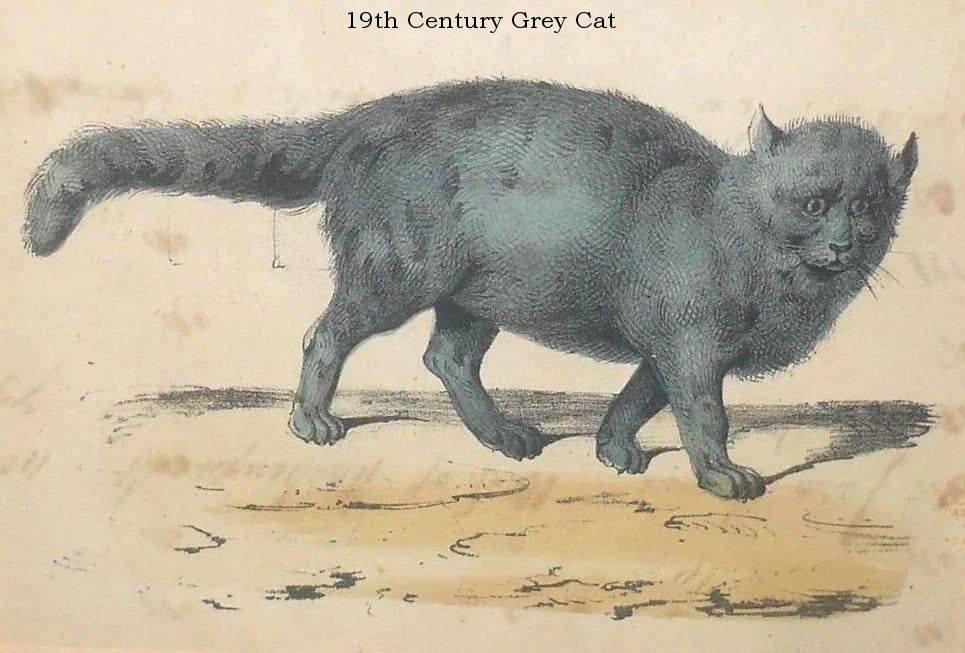
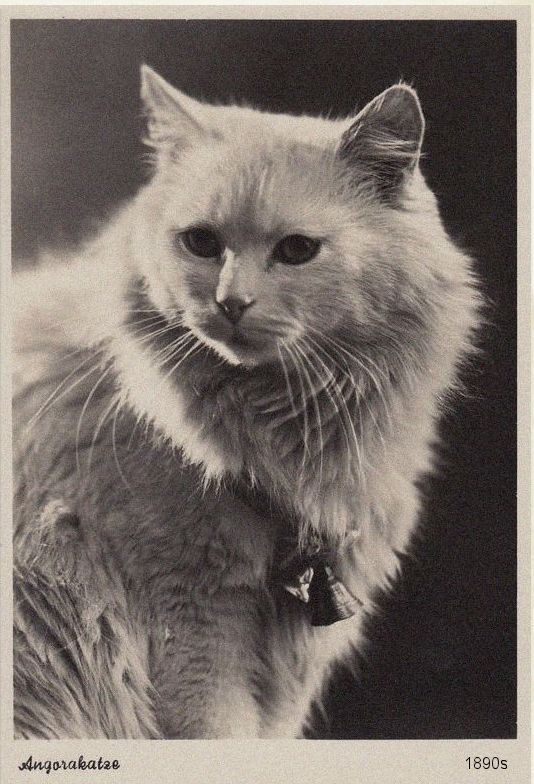
By 1903 the Persian had replaced the Angora and by the 20th century the Turkish Angora was virtually unknown outside of Turkey. In Turkey, they were seen in many colours e.g. sarman (red tabby), teku (silver tabby), Ankara kedi/Van kedi (odd-eyed white), brown tabby, selfs (solids), torties and tortie-and-white although some cat fanciers still claim that the white Angora is the only pure native Turkish Angora. There is a true-breeding colour variant found near Lake Van originally known in Britain as the Turkish Cat (or Turkish Swimming Cat) and later as the Turkish Van. In Turkey the name "Van kedi" (Van cat) refers to the highly prized odd-eyed white. Turkish Vans are auburn (red) and white with the colour restricted to around the ears and on the tail. They are also known to swim in shallow pools and streams.
In their study comparing the genetics of several breeds (Lipinski MJ, et al., The ascent of cat breeds: genetic evaluations of breeds and worldwide random-bred populations, Genomics (2007), the American Turkish Angora breed and the American Turkish Van breed were found to be distinct from each other. The American Turkish Van was related to Egyptian random-bred cats while the American Turkish Angora was closer to random-bred cats from Tunisia and Turkey. Lipinski suggested that cats may have spread into different regions of Turkey from different directions: into the Lake Van region from Egypt via land trade routes and into the Ankara (Angora) region from Tunisia via sea routes. Cat fancy history also refers to "Russian Angoras" suggesting a historical link between Russian and Turkish longhaired cats. Studies of Turkish Angoras maintained as a pure breed at the Ankara Zoo found that the American "Turkish Angora" is not closely related to the authentic Turkish cats. The American version was bred from Persians and other cats to "resemble" the Angora and is physically and genetically different from true Turkish cats.
|
|
|
Angoras were extinct in Britain until after World War II. In the 1950s and 1960s, Turkish cats were taken to North America, Sweden and Britain, but only the Van cats were bred and recognised in Britain. In the US, white Turkish Angoras were recognised in the early 1970s and other colours in 1978. They are now recognised in a full range of colours including black, blue, tabbies, tortie-and-white and smoke colours. Turkish Angoras have silky coats and gentle dispositions.
Meanwhile, in Britain the name "Angora" was given to an impostor! In 1977, a breed confusingly known as the Angora was recognised in Britain. Although similar to the Turkish Angora, it is bred in a wider range of colours (including chocolate and lilac, which come from Siamese ancestry), its voice is similar to that of the Siamese and it is more fecund than the Turkish Angora. The British Angora is a Foreign Longhair bred to recreate or resemble the Turkish breed rather than reintroduce genuine Turkish cats. It is related to the Oriental and Balinese. Elsewhere in Europe it is known as the Javanese or Mandarin; in the USA it is a Foreign Longhair. The British Angora is more foreign in type with a longer, narrower head and larger ears than the Turkish Angora. This situation was rectified in 2002 when Britain's GCCF came into line with other registries and called the British variety Oriental Longhairs, thus removing confusion with the original Turkish Angora cats.
The possibility of importing Turkish Angoras was apparently considered, but bureaucracy prevailed since the British GCCF would apparently not accept the documentary evidence (verification of breed) supplied by the Ankhara Zoo. If true, then the British cat fancy places more importance of paperwork than on actual physical felines; a serious drawback where naturally occurring varieties are concerned! Importation of either Turkish or American lines of Turkish Angora would mean 6 months quarantine.
Breeders of the British Angora have attempted to recreate the characteristics of the original Turkish cats. Those working with Turkish Angoras/Vans have worked to preserve characteristics of those naturally occurring breeds and the Turkish Angora has prior claim to the Angora name. Luckily the genuine Turkish Angora has since returned to Britain.
The most obvious differences between the Turkish Angora, British Angora and Persian are the coat, head shape and general conformation. The British Angora is an oriental cat - long-bodied with a longer, wedgier head and larger ears. The Turkish Angora is less foreign in build, with a wider, shorter head and smaller ears. The Persian has a wide head, flat face, small-ears and extremely cobby build. In addition, the Persian has longer fur with a woolly undercoat and a tendency to tangle or knot. The Angora coat is silkier without the woolly undercoat; the full Angora coat is seen in the winter - in summer, they moult and may look like shorthairs with fluffy tails.
In an article in the Colourpoint, Rex-coated and AOV Club's Journal (reported in 1981 by cat breeder Phyllis Lauder), Robin Sims made the point that though the terms "Persian" and "Angora" were often used interchangeably, the cats concerned were not the same and that the flowing coats of the cats imported into Europe from Iran were not governed by the same gene as that concerned with the cats imported from Ankara. Sims made it clear that the Turkish Van were Angoras, and held the opinion that it was unfortunate that in the early 1900s the Angora was used to improve the coats of the Persians.
Angora Breed Club (flyer inside 1997 catalogue for the Siamese Cat Association 21st championship show.)
The ANGORA is the longhaired version of the Oriental just as the Balinese is the longhaired version of the Siamese. Alternatively, the Angora could be considered to be the full coloured equivalent of the Balinese in the same way as the Oriental is the full coloured equivalent of the Siamese. In the eighteen-nineties some Longhaired cats were referred to as "Angoras"; these were supposedly distinguished from the Persians by having a more angular head, larger ears and a longer, silkier, uneven coat. By the early nineteen-hundreds the Angora was no longer recognised as a separate breed and some authors of the day doubted that it ever had been distinct. The "Angora" was then forgotten for many years and the only accepted Longhaired breed in Britain was the Persian. Other longhaired breeds were introduced: Turkish Vans were imported and then Birmans. Balinese (longhaired Siamese) appeared on the show bench in 1975 and in 1981 the first Somalis (longhaired Abyssinians) were born in this country. Maine Coons were given Preliminary recognition in 1988 and now have Championship status. Norwegian Forest Cats were recognised in 1989, Ragdolls in March 1990 and finally the Tiffanies (longhaired Burmese and Asians) in September 1990. Unfortunately the Angoras have lagged behind although they have been recognised almost as long as the Balinese and far longer than the Somalis.
In the late 60's and early 70's, Kernow Gerza and Kernow Koptos, offspring of a mating between a Sorrel Abyssinian and a Seal Point Siamese, were used by Maureen Silson in her breeding programme. In 1971, from the brother-sister mating of these cats, Maureen bred Southview Pavane, the first Oriental Cinnamon. However, these two had inherited more than the light brown (cinnamon) gene from their Abyssinian sire - they had also inherited the gene for longhair and passed this on to several of their kittens. Although not the first to be produced, the first Southview longhair to cause excitement was Trappist, a "longhaired Havana" who was born in 1973. Trappist, known to his friends as "Cuckoo", was used for breeding and was on exhibition at the 1978; Supreme-Show. This was the start of today's Angoras - the Oriental Longhairs - who are not related to the Angoras of the last century or to the Turkish Angoras which are recognised by some Fancies overseas. Many of the immediate descendants of Kernow Gerza and Kernow Koptos proved to carry the longhair gene and are behind the majority of today's Angoras. In order to maintain the breed, Angoras were mated out, first to Siamese and Orientals and then to Balinese as well when these became available and these matings are still the basis of the Angora breeding programme. There are now more Angora breeders and some new lines have been produced by mating Orientals to Balinese and breeding the resulting full-coloured, short-coated variants back to Balinese. The Angora breed is now increasing in numbers and in the interest they are causing and the ANGORA BREED CLUB was formed to encourage the breeding and showing of Angoras under GCCF Rules; we hope to help them on their way, eventually, to the Championship status they deserve.
We have, so far, drawn up a revised Standard of Points for Angoras and a Registration Policy, both of which have been approved by the GCCF. We offer rosettes to Members' Angoras for each Merit awarded, plus special rosettes for cats who gain four qualifying Merits, and hope eventually to gain Affiliation to the GCCF so that we can offer Club classes for our Angoras. We can also supply Standards of Points for the individual colours for use at Shows.
Persians
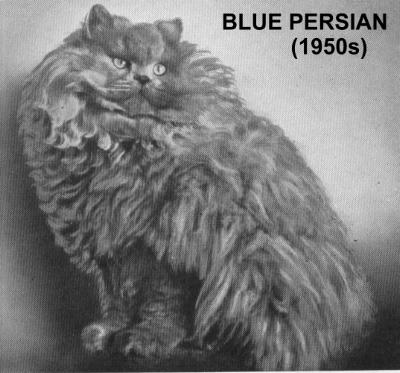
In 1868 Charles Ross described the Persian as "a variety with hair very long and very silky, perhaps more than the Cat of Angora; it is however differently coloured." The cats most likely to win prizes at early cat shows were those which combined the Angora's longer fur with the Persian's shorter faces. The Turkish blue-eyed white cats were crossed with shorter-nosed blacks, blues and fawns (creams). The whites became shorter-faced, but the distinctive blue eyes were often replaced by orange eyes or odd eyes. Another reason for cross-breeding might have been to tackle the problem of deafness in blue-eyed white Angoras.
In the 19th century, Harrison Weir described Persians in white, black, blue, grey, red and "any other" self colour; tabbies were recognised in brown, blue (black markings on blue background, possibly black-silver tabbies), silver and light grey-and-white (probably blue-silver tabbies). In 1872 Weir described smoke Persians, "a beauty was shown at Brighton, which was white with black tips to the hair, the white being scarcely visible unless the hair was parted". The following year these were numerous enough to have their own classes. The British National Cat Show of 1879 included a Persian with a coat of "strangely graduated grey" (possibly chinchilla or shaded silver). Chocolates, lilacs and tortoiseshells were not described. Creams, then called fawns, or derisively as "spoiled oranges", were first recorded in 1890 and were darker in colour than they are today. The first Smoke Persian Champion (1893) was Mrs H. V. James's Backwell Jogram and it is worth noting that he is completely different to the modern Smoke Persians and (judging from photos) bears a striking resemblance of type to the modern Siberian Longhair.
In her 1903 "The Book of the Cat", Frances Simpson did not distinguish between the Persian and Angora and did not mention the Russian Longhair. She wrote in "In classing all long-haired cats as Persians I may be wrong, but the distinctions, apparently with hardly any difference, between Angoras and Persians are of so fine a nature that I must be pardoned if I ignore the class of cat commonly called Angora, which seems gradually to have disappeared from our midst. Certainly there is no special classification given for Angoras, and in response to many inquiries from animal fanciers I have never been able to obtain any definite information as to the difference between a Persian and an Angora cat. Mr Harrison Weir, in his book on cats, states that the Angora differs somewhat from the Persian in that the head is rather smaller and ears larger, fur more silky with a tendency to woolliness."
She considered the Persian to be less reliable in temperament than the English short-hairs, but considered them more intelligent and also keen hunters. However, they were less healthy than short-hairs and the longest haired kittens were the most difficult to rear. She attributed these health problems to in-breeding. Persians were disadvantaged by the fact that cat shows were held in the summer months (many were held in marquees), at a time when long-haired cats were moulting and tended to look moth-eaten and unkempt. This, she felt, held them back - not that the numbers shown upheld this opinion, long-hairs outnumbered English short-hairs by about four to one!
According to John Jennings "Domestic or Fancy Cats", published a little earlier than Simpson's work, "Of the many varieties or breeds of the cat with which we are now familiar, it must be remembered that, however crossed, selected, re-crossed, domesticated, or what not, we have but two breeds on which the super-structure of what is known today as the 'classification of varieties' has been reared - viz, the long-hair or Eastern cat, and the short-hair or European." Jennings found little difference in the skull length between those long-hairs and short-hairs; indicating that the Victorian long-hairs had not yet become the snub-nosed cats familiar to 21st Century cat lovers.
When Weir drew up his "points of excellence" for judging cats in 1889 he defined differences between the Angora and the Persian. Pocock later stated (1907) that Persians had a marked shortening and widening of the face i.e. it had diverged from the Angora. In addition, the Angora had sleeker fur, lacking a woolly undercoat. By 1903, Simpson had effectively dismissed the Angora cat in favour of the Persian type. Only in very recent times has the true Turkish Angora come back from being thus relegated in Britain.
|
|
|
|
By 1901 the colours were black, white, blue, orange (red selfs, red tabbies), cream or fawn, sable, smoke, tabby, spotted, chinchilla, tortoiseshell, bicolour and tricolour (tortie-and-white). True spotted Persians were described as being rare or non-existent; almost all had some tabby lines and rings. In fact the long flowing coat of the Persian does not lend itself well to spotted or mackerel tabby patterns. The sables were described in a 1903 book as "a kind of brown tabby ... These cats have not the regular tabby markings, but the two colours are blended one with another, the lighter sable tone predominating" which suggests shaded goldens. The orange (red self) was always popular and by 1915 there were classes for red self or shaded and for red tabbies. Blue-creams were recognised in 1929.
Persians arrived in North America from Europe towards the end of the 19th century and by the turn of the century they were eclipsing the native Maine Coon. Frances Simpson was an early champion of Persians and devoted considerable space in her 1903 book "The Book Of The Cat" to Persians "distinguished by unusually long coats, round heads, tiny ears, and wonderful toe tufts" (she also included the Maine Cat in her book as we shall see later on).
Simpson wrote "A gentleman who has lived for ten years in Assam says that he never saw in that part of India any long-haired cats except blue-eyed whites" although these seemed mainly to belong to English colonials, rather than being native cats. At around the same time, Mrs. Clinton Locke, president of the Beresford Cat Club, wrote in a letter to "Our Cats" "The first white Persian I ever owned was brought to me many years ago from Persia by a distinguished traveller, and its eyes were amber".
The White Persian was especially popular: "There is always a keen demand for white kittens, either as pretty pets or, if with correct-coloured eyes, for breeding purposes, and, doubtless, when more encouragement is given to this beautiful variety, there will be an increase of fanciers of the white cat, whose praises have been sung in fairy tales, nursery rhymes, and by novelists who have a weakness for describing interiors with a beautiful white Persian cat reclining on the hearthrug."
"Whereas formerly blue eyes were considered quite a rarity, now it is seldom we see any yellow-eyed white cats exhibited at our principal shows [...] It is easy to tell whether the baby blue eyes are likely to retain their colour or turn yellow. If at about three weeks or a month old the blue becomes tinted with green, then surely but sadly may we make up our minds that these kittens have not a distinguished career before them, for they will see and be seen with yellow eyes." A well-known authority on cats, wrote in a letter to one of the cat papers, "A few years ago white cats with green or yellow eyes frequently were prize-winners, and a blue-eyed white was looked upon as a rarity. Now blue eyes have it all their own way." Occasionally green-eyed White Persians turned up, hinting at Russian Angora ancestry.
Imported longhairs (probably then of Angora type) were considered better quality than British-bred cats: "the most perfect type of a white Persian is assuredly to be found amongst the imported cats; there is a certain beauty of form and silkiness of fur which is not possessed by the specimens bred in this country [...] These imported cats are often of a rather savage disposition, and, although they can be sweet-tempered enough with human beings, they are extremely fiery with their fellows."
|
|
|
In 1906 a Canadian writer described the conformation of one Persian thus: "His head is magnificent, and he is short on the leg, has plenty of bone" and the best Persians were reckoned to come from Britain. In the 1960s, Fernand Mery wrote that the development of longhairs into extremely cobby cats was due to either the British climate or was a British preoccupation since the British had done the same thing with the Chow dog breed.
Persians were also favourite photographic subjects as Sydney W France's noted (with some dismay) in his book "Siamese Cats" (1949) though he was good enough to list the various colours of Persian: "Take a look at any cat magazine, or at any cat photographs you may see in the papers or periodicals. Mostly of the long-haired cats, are they not? Chinchillas, Blue Persians, Biscuit, Smoke, White Persians." The "Biscuit" colour sounds to be cream or fawn. Grace Cox-Ife, author of "Questions Answered About Cats" (1947) lists the official Persian colours as Black, White (blue-eyed, orange-eyed), Blue, Red Self, Cream, Smoke, Silver Tabby, Brown Tabby, Red Tabby, Chinchilla, Tortoiseshell, Tortoiseshell-and-White and Blue-Cream.
In a study comparing the genetics of several breeds (Lipinski MJ, et al., The ascent of cat breeds: genetic evaluations of breeds and worldwide random-bred populations, Genomics (2007), the Persian breed was more closely related to random bred cats of Western Europe/America than to random-bred cats from the Near East. Their study also found the Persian to be derived from multiple lineages. This accords with breed histories describing it as derived from Turkish, Russian and British longhaired cats. Although Lipinski's team were surprised by the result, it did not come as a surprise to those versed in Persian breed history!
The modern Persian has evolved to have longer hair, a denser undercoat, a wider, flatter face, shorter muzzle, smaller wide-set ears, shorter body and tail and large round eyes. The lighter-bodied type of the early Angoras was lost and the modern Persian bears little or no resemblance to the original imports. However, the early ancestors of the Persian are once more being recognised in the form of the Turkish Angora and the Siberian.
In Britain, the cats became known as Longhairs, though most still call them Persians or Persian Longhairs to distinguish them from other long-haired breeds. In the USA, Persian is the official breed name although some American associations do not recognise the chocolate or lilac solid (self) colours introduced via Himalayan (Colourpoint Longhair) breeding programmes; these are known as Kashmirs. In some American registries, non-colourpointed cats of Himalayan origin are called the Himalayan Reflections or Self Himalayan. Thankfully some have seen fit to sort out the muddle so that Persians and Himalayans can be interbred and some offspring are known as Colourpoint Carriers (CPCs). The history of the Himalayan is in Colourpointed and Masked Cats.
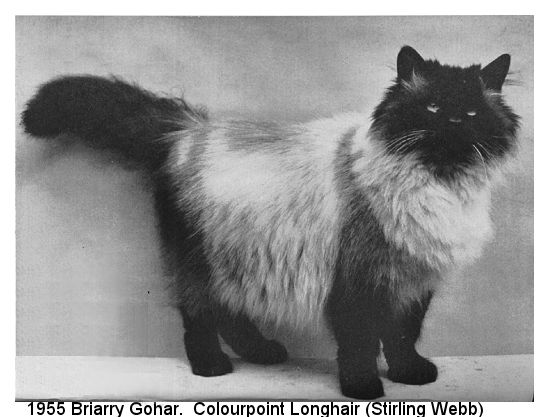 |
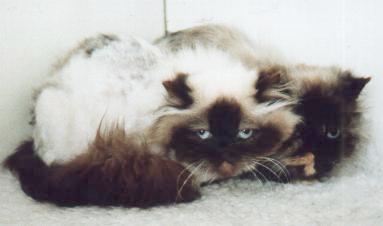 A 1950s colourpoint longhair and the 1990s equivalent |
The British system had its own perversities - each variety of Longhair being regarded as a separate breed, not as a colour variation of a single breed. The Chinchilla is therefore seen as a different breed to the Blue Longhair! Conformation does differ across the Longhair "breeds" and some of the Chinchillas remained less ultra-typed than the selfs. Chinchillas were reckoned to be several years behind other Persians in terms of extreme-typing.
During the mid 1970s and early 1980s, American Persians changed dramatically. The pre-1980s look had heavy brows, flat-topped heads rather than the domed heads. The "sweet, open-expression" was lost as fanciers pursued the extreme head type (ultra-type). These were dubbed "pigs" or as having a "piggy expression." The nose became narrow and ultra-high; the breaks above the eyes were moving upwards into the foreheads; the eyes were tiny and the jaws often maloccluded to produce a frowning mouth. It is suggested that Peke-Face reds Persians were bred to other colour Persians to produce the piggy look and the teardrop-shaped eye of modern ultras is attriubted to the Peke-face cats. The new look was deemed an exciting development and open-ended standards favoured these cats on the showbench. During the 1990s, both open-face and Persian pigs were advertised, but the trend is now back to the healthier open-face cats.
True Peke-face Persians (solid red and red tabby) generally conformed to the red Persian standard, but only 98 had been registered with the CFA beteen 1958 and 1993 (the 3 registered between 2000 and 2002 may not have been genuine Peke-face Persians). They had higher ears and a different skull structure that produced a very round head with a strong chin and very wide-set eyes. The nose was depressed and indented between the eyes. The muzzle was wrinkled and there was a horizontal break located between the usual nose break and the top dome of the head. This second break created half-moon boning above the eyes and an additional horizontal indentation in the center of the forehead. The Standard for the Peke-Face called for a brow ridge, dimple, and a double dome. The term peke-face is often incorrectly used to describe extreme-type Persians.
|
|
|
While American breeders were the first to breed the Persian to extremes, practically eliminating the cat's muzzle, British breeders are now following suit with ultra-typed Persians which find favour on the showbench but less favour with the general public who prefer the older, less extreme facial conformation. Personally I find the ultra-typed Persian ugly and they are more prone to breathing problems and tear duct problems than those of more moderate type. In the USA, the older type is now preserved as a traditional style Persian (bizarrely the breeder does not like the actual breed name used in reviews in case it erodes, rather than promotes, the breed). For a short while, American breeders developed the Peke-Face Persian. This arose as a mutation in red/red-tabby Persians and suffered from breathing problems, tear duct problems, high palate (making suckling difficult) and sometimes the head was too massive for kittens to be born naturally (Caesarian section needed). These have now vanished, but the ultra-types are becoming almost as extreme.
In 1872, Dr Gordon Stables, in his review of cat shows, had noted that "urbanity of countenance" should not be overlooked when judging Red Tabbies; the modern equivalent would be "a pleasing expression". In 1981, Phyllis Lauder noted that the Peke-faced Persian (bred only in the USA) was a solid red or red tabby longhair (there being no Peke-faced Exotic Shorthair equivalent) with a very different expression to that of a regular Persian. Like Pekinese dogs, they had prominent eyes, sometimes described as "owl-eyed". It was debatable whether these cats (or indeed the modern ultra-types) could be said to have a pleasing expression.
The Persian is still evolving. The Mink Longhair (Mink Persian) is a Persian Longhair in the Tonkinese (mink) colour series. Similar cats have been experimentally in different countries under a variety of names and since about the 1960s. They are attractive cats, but have yet to attract a serious following or achieve formal recognition. Other names used for this variety include Burmalayan, Himbur, Iranese, Layanese, Silkanese, Tibetane/Tibetaan and Tonkalayan (some resemble Persians, other resemble Tonkinese). Mink Persians would seem a logical and attractive development. The Napolean Cat Longhair is a short-legged Persian bred through outcrossing Persians to Munchkins in the 2000s.
To add confusion to the Persian story, there is also the Exotic Longhair. Longhaired individuals are sometimes born to Exotic Shorthair parents due to the recessive nature of the gene for longhair. In many registries, they are not accepted in the Persian class due to their non-Persian parentage. In addition they may have a relatively poor coat compared to Persians born of Persian parents. However, they are accepted as Exotic Longhairs by some registries in the USA/ The original proposed name was Tiffany, due to the original conception that the Exotic Longhair was to be allowed in silver colurs only.
Russian Longhairs
Harrison Weir, founding father of the cat fancy and organiser of the first formal cat show (also writer of the first standards for pedigree cats), wrote about the Russian Longhairs in "Our Cats" in 1889. The cat he described differs from the modern Siberian cat, for example it was woollier, although cats of the old Russian Longhair type apparently still exist among domestic longhairs in parts of Russia.
The Russian Longhair male described by Weir differed from the Angora and the Persian in many respects, being "larger in body with shorter legs. The mane or frill was very large, long, and dense, and more of a woolly texture, with coarse hairs among it; the colour was of dark tabby, though the markings were not a decided black, nor clear and distinct; the ground colour was wanting in that depth and richness possessed by the Persian, having a somewhat dull appearance. The eyes were large and prominent, of a bright orange, slightly tinted with green, the ears large by comparison, with small tufts, full of long, woolly hair, the limbs stout and short, the tail being very dissimilar, as it was short, very woolly, and thickly covered with hair the same length from the base to the tip, and much resembled in form that of the English wild cat."
According to Weir, its motion was less agile than other cats and it did not care for warmth, preferring to be outdoors in the coldest weather. Another peculiarity was that it seemed uninterested in hunting birds. Its habits were not like those of its companion shorthaired cats. It attached itself to no person, but was inseparable from a shorthaired, silver-gray tabby female. This pair produced a single black-and-white kitten. The kitten inherited the woolly coat, had somewhat of a mane and a short bushy tail. It also seemed uninterested in birds, but would attack rats!
"I have seen several Russian cats, yet never but on this occasion had the opportunity of comparing their habits and mode of life with those of the other varieties; neither have I seen any but those of a tabby colour, and they mostly of a dark brown. I am fully aware that many cross-bred cats are sold as Russian, Angora, and Persian, either between these or the shorthaired, and some of these, of course, retain in large degree the distinctive peculiarities of each breed." However to the practised eye, it was possible to distinguish whether the cat was Angora, Persian of Russian. Unfortunately, these were all judged together in a longhaired class and not as distinct breeds; something which ultimately led to the loss of the Angora and Russian types.
I have seen some 'first-cross cats' that have possessed all, or nearly all, the points requisite for that of the Angora, Persian, or Russian, while others so bred have been very deficient, perhaps showing the Angora cross only by the tail and a slight and small frill. At the same time it must be noted, that, although from time to time some excellent specimens may be so bred, it is by no means desirable to buy and use such for stock purposes, for they will in all probability 'throw back' - that is, after several generations, although allied with thoroughbred, they will possibly have a little family of quite 'short-hairs'. I have known this with rabbits, who, after breeding short-haired varieties for some time, suddenly reverted to a litter of 'longhairs'; but have not carried out the experiment with cats."
Weir noted that he had never seen tabbies among the shorthaired Russian cats, but the Russian Longhairs were all brown tabbies except for two black Russian Longhairs, which he supposed were the offspring of tabby or grey parents. He did not recall having seen any white Russian Longhairs and wrote "I should feel particularly obliged to any of my readers who could supply me with further information on this subject".
In 1926, Dr Jumaud's book "Les Races des Chats" (The Breeds of Cats), which was based largely on the works of Professor Cornevin of Lyons, described the Carthusian cat (felis catus carthusianorum) and Tobolsk cat. The Carthusian was apparently the "Maltese cat" known the the Americans, though Jumaud's description referred to a large head with large, full eyes, short nose and small, erect ears. Its coat, he said, was half long and woolly and the colour was grey with bluish reflections. However, there was another variety of Russian cat known as the Tobolsk variety: "This variety, described by Gmelin, exists in Siberia, and is sometimes called the Tobolsk cat. It is larger than our common cat, and somewhat resembles the Carthusian in shape. The head is large, with big eyes, short nose, and small erect ears. Coat: as is fitting for an animal of a cold country, the Tobolsk cat has long fur, longer than that of the Chartreuse cat. Its texture is woolly, and in colour, uniformly reddish."
In 1927, Mrs Amy Lawrence wrote "In the Natural History Museum [South Kensington, London] there is an enormous cat which is said to be a 'Russo-Persian' cat. It has an immense coat, and is similar in every way to a Persian long-hair, except that it is larger than any specimen I have ever seen. An old uncle of mine possessed what HE called a Russian cat, also a long-hair with immense coat and very large." However the only "Russian" cats Mrs Lawrence had seen at cat shows was the small short-haired Russian Blue that looked like a blue Siamese cat! Her uncle's huge Russian cat had been a tabby.She wondered "Do Blue Russians really come from Russia, and if so, then where do those immense long-hairs come from, and why were they called Russians even by Museum authorities?"
In 1967, when the CFA was proposing to accept the Turkish Angora, they gave a table comparing it to the Persian and the Russian (a longhair recognised at the dawn of the cat fancy and now considered the forerunner of the Siberian).
